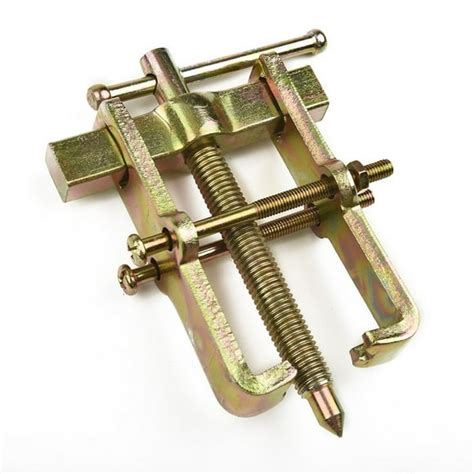A Comprehensive Guide to Needle Bearing Pullers: Essential Tool for Industrial Maintenance
Introduction:
Needle bearings are widely used in various industrial applications due to their high load-carrying capacity, low friction, and compact size. However, removing and installing these bearings can be challenging without the proper tools. A needle bearing puller is an indispensable tool designed to safely and efficiently remove needle bearings from shafts and housings. This comprehensive guide will delve into the intricacies of needle bearing pullers, their types, applications, and essential strategies for effective usage.
Anatomy of a Needle Bearing Puller
A needle bearing puller typically consists of the following components:
-
Pulling Head: The pulling head is the heart of the puller. It has hardened jaws that grip the inner race of the needle bearing securely.
-
Hydraulic Cylinder: The hydraulic cylinder provides the necessary force to extract the bearing from its seat. It can be either manual or powered.
-
Base Plate: The base plate provides stability and support to the puller.
-
Safety Shield: A safety shield is often included to prevent debris from flying during the pulling operation.
Types of Needle Bearing Pullers
Needle bearing pullers come in various types, each designed for specific applications. Some common types include:
-
Mechanical Pullers: These pullers use a screw mechanism to apply force and extract the bearing. They are suitable for light-duty applications.
-
Hydraulic Pullers: Hydraulic pullers use hydraulic pressure to generate force. They are more powerful and can handle heavier-duty applications.
-
Slide Hammer Pullers: Slide hammer pullers use a sliding hammer to apply force. They are ideal for removing bearings that are tightly fitted or have limited access.
Applications of Needle Bearing Pullers
Needle bearing pullers are used in a wide range of industrial maintenance and repair operations, including:

- Removing needle bearings from shafts and housings
- Installing needle bearings onto shafts
- Repairing damaged needle bearings
- Inspecting and cleaning needle bearings
Effective Strategies for Using Needle Bearing Pullers
To ensure safe and effective use of needle bearing pullers, follow these strategies:

-
Choose the Right Puller: Select a puller with the appropriate pulling capacity and jaws to fit the size and type of needle bearing.
-
Prepare the Work Area: Clear the work area and ensure that the surface is stable and level.
-
Lubricate the Bearing: Apply lubricant to the bearing to reduce friction and prevent damage.
-
Position the Puller: Carefully position the puller on the bearing, ensuring that the jaws are securely engaged.
-
Apply Force Gradually: Apply force gradually to the puller to avoid sudden shock or damage to the bearing.
-
Inspect the Bearing: Once the bearing is removed, inspect it for any damage or wear and replace it if necessary.
Common Mistakes to Avoid
Avoid the following common mistakes when using needle bearing pullers:
-
Using the Wrong Puller: Using a puller that is not designed for the size or type of needle bearing can result in damage to both the puller and the bearing.
-
Over-tightening the Jaws: Over-tightening the jaws can crush the bearing or damage the shaft.
-
Applying Excessive Force: Excessive force can damage the bearing or the puller.
-
Neglecting Lubrication: Failing to lubricate the bearing can increase friction and cause damage.
-
Ignoring Safety Precautions: Always wear appropriate safety gear and follow safety protocols to prevent injuries.
Interesting Stories and Lessons Learned
-
The Case of the Stubborn Bearing: A maintenance technician was struggling to remove a needle bearing from a shaft using a manual puller. Despite his efforts, the bearing refused to budge. He eventually discovered that the bearing was corroded and had become stuck to the shaft. By using a penetrating lubricant and applying gentle heat, he was able to free the bearing without damaging it.
-
The Magic of the Hydraulic Puller: A repair technician was tasked with removing a needle bearing from a high-pressure pump. He initially tried using a mechanical puller but found that it was not powerful enough to extract the bearing. By switching to a hydraulic puller, he was able to remove the bearing effortlessly and without damaging the pump housing.
-
The Importance of Lubrication: A maintenance team was experiencing premature failure of needle bearings in their equipment. After investigating, they realized that they were not lubricating the bearings properly. By implementing a regular lubrication schedule, they significantly extended the lifespan of their bearings and reduced downtime.
Conclusion:
Needle bearing pullers are essential tools for any industrial maintenance or repair facility. By understanding their types, applications, and effective strategies, technicians can safely and efficiently remove and install needle bearings. Avoiding common mistakes and adhering to safety precautions will ensure the longevity of both the puller and the bearings it is used on. By following the guidelines outlined in this comprehensive guide, technicians can maximize the effectiveness of their needle bearing puller operations and contribute to the smooth operation of their industrial machinery.

